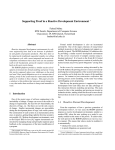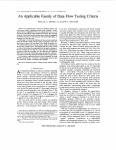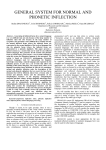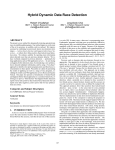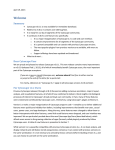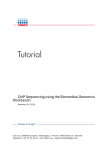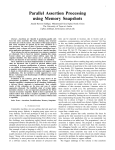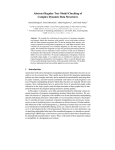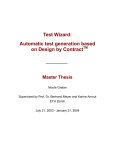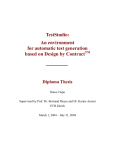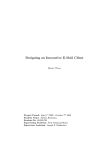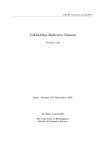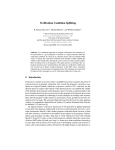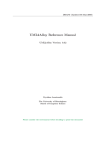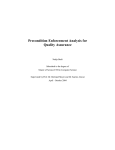Download Paper
Transcript
Using contracts and boolean queries to improve the
quality of automatic test generation
Lisa (Ling) Liu
Bertrand Meyer
Bernd Schoeller
Chair of Software Engineering,
ETH Zurich, Switzerland
{ling.liu, Bertrand.Meyer, bernd.schoeller}@inf.ethz.ch
Abstract. Since test cases cannot be exhaustive, any effective test case generation
strategy must identify the execution states most likely to uncover bugs. The key issue
is to define criteria for selecting such interesting states.
If the units being tested are classes in object-oriented programming, it seems
attractive to rely on the boolean queries present in each class, which indeed define
criteria on the states of the corresponding objects, and — in contract-equipped O-O
software — figure prominently in preconditions, postconditions and invariants. As
these queries are part of the class specification and hence relevant to its clients, one
may conjecture that the resulting partition of the state space is also relevant for tests.
We explore this conjecture by examining whether relying on the boolean queries of
a class to extract abstract states improves the results of black-box testing. The
approach uses constraint-solving and proof techniques to generate objects that satisfy
the class invariants, then performs testing by relying on postconditions as test oracles.
The resulting strategy, in our experiments on library classes used in production
software, finds significantly more bugs than random testing.
1 Overview
Unlike other approaches to improving program quality, in particular proofs, program
testing focuses not on guaranteeing the absence of bugs but on uncovering bugs. This
is by itself a very interesting goal since any bug removed is a significant improvement
to a program.
The effectiveness of a testing strategy is, as a result, defined by how likely it is to
uncover bugs. We present a testing strategy for classes — object-oriented program
units — that takes advantage of two of their distinctive properties: the presence of
boolean queries as part of the interface of a class, and in some programming
formalisms, the use of contracts to specify abstract properties of classes.
The topic of this paper is, as a consequence, simple. We state a conjecture: that
using contracts and queries will improve the effectiveness of testing strategies. Then
we assess the validity of that conjecture by applying contract- and query-based testing
through our automatic test environment, AutoTest [5], and measuring whether this
improves AutoTest’s effectiveness in finding bugs.
A characteristic of our testing work is that (rather than artificial examples, although
one will be used to illustrate the concepts) it applies testing strategies and in particular
the AutoTest tool to actual production software, in particular the EiffelBase library of
fundamental data structures and algorithms, used daily in mission-critical production
environments. Testing for us is then not just an academic pursuit but also a very
practical attempt to find bugs in actual software. Along with the concepts we propose,
the main concrete result of the study reported here is that it has enabled us to find and
correct real bugs in software components that are in actual use, and hence provide a
tangible benefit to the users of those components.
1.1 Correctness and contracts
The correctness of a program element is not an absolute property but is always
defined with respect to a certain specification. In the “Design by Contract” approach
[18], the specification is present in the text of classes (the program units of objectoriented programming) in the form of invariants for classes, and preconditions and
postconditions for routines1. Ascertaining the correctness of a class in languages that
natively support such mechanisms —Eiffel [19] or Spec# [1] —, or in contract addons to Java (such as JML [13, 14], iContract [12]) or UML (Object Constraint
Language [23, 8]), means ascertaining that the implementations are consistent with
the contracts: specifically, that every creation procedure (constructor) yields an object
satisfying the invariant of its class, and that every exported routine, started in a state
satisfying the invariant and the precondition, terminates in a state satisfying the
invariant and the postcondition.
Using testing we cannot prove such correctness for any realistic program, but we
can uncover correctness violations — bugs — by finding inputs that will cause
routine executions to violate an invariant or postcondition.
1.2 Testing and program states
Because the set of possible program execution states is inexhaustible, any practical
testing strategy must identify a subset of interesting states, where “interest” is defined
— in the negative mindset that characterizes the work of the tester, whose reward is to
prove software incorrect — as likelihood to uncover bugs. Usually this is achieved
through a partitioning approach which, using appropriate criteria, divides the state
space into disjoint parts, then picks one state (or a few) from each such part, with the
expectation that each selected state is somehow representative of that part.
A common approach for such partitioning is to use white-box tests, based on an
analysis of the implementation’s control flow, such as “path coverage” and “branch
coverage”. This has two disadvantages. First, the tester needs access to the
implementation, which may be an unrealistic requirement in the presence of
information hiding. Second, the approach requires possibly complex computation to
exercise specific branches or paths.
1.3 Query-based testing
The approach described here relies instead on a black-box testing strategy, based on
contracts. Specifically:
1
“Routines” are called “methods” in Java and C++. This paper uses Eiffel terminology and
notation.
•
•
•
•
Instead of relying on the implementation of a class, it uses its contracts and its
boolean queries to partition the state space.
The partitioning is aided by an insight into the structure of good contracts, the
Boolean Query Conjecture, defined below.
Techniques from boolean constraint solving and program proving help reduce the
resulting state space further.
Then we develop a test strategy - boolean query coverage to achieve complete
test coverage based on the outcomes of this reasoning.
The main contributions of this paper are the following:
1.
New application of Design by Contract techniques to improve the testing
process.
2. A new method for partitioning program state, applied here to testing but (we
think) with potential applications elsewhere, for example in model checking.
3. The experimental validation of that method on concrete examples.
4. New techniques for improving test coverage.
5. The integration of constraint-solving and program-proving techniques in a
testing framework.
6. A technique for taking advantage of test results to improve not only test
coverage but also class designs (through stronger invariants).
7. Concretely, as noted, the detection through an automatic procedure (and
subsequent correction), in actual production libraries, of real bugs, until now
unsuspected and not found by any previous technique, manual or automatic.
Section 2 presents the notion of boolean query and introduces the conjecture behind
this work’s approach to testing, as well as the method for assessing the conjecture.
Section 3 explains the overall strategy based on contracts, the notion of abstract state
space, constraint satisfaction techniques, proof techniques, and the AutoTest
framework. Section 4 describes the experimental study applying this strategy to a set
of actual classes, and analyzes the result. Section 5 discusses related work, and
section 6 discusses future work.
2. The role of boolean queries
The central issue of test case generation is, as noted above, to maximize the likelihood
of uncovering bugs. If we are testing object-oriented software we should take
advantage of the distinctive structure of O-O programs.
2.1 Classes and object states
A class is often an implementation of an abstract data type, providing all the
operations, or “features”, on a certain type of run-time objects. These features are of
two kinds [18]:
•
Commands modify the corresponding object: withdraw money (for a class
representing bank accounts), open (for a class representing files), increase indent
(for a class representing paragraphs in a text).
• Queries return information about an object: current balance, number of
characters, margin size.
Both commands and queries can be exercised on a particular object through a “feature
call” written, in most object-oriented languages, through dot notation, as in
my_account.withdraw (500)
b := my_account.balance
2.2 Argumentless boolean queries
Among queries, boolean queries are of particular interest, especially boolean queries
without arguments. Examination of object-oriented libraries such as EiffelBase [17]
and others indicates that 90% classes are equipped argumentless boolean queries.
Examples include:
• In a bank account class, is_overdraft.
• In a paragraph class, is_justified.
• In data structure classes, is_empty and (if the representation has limited capacity)
is_full.
• In a list class where lists have cursors indicating a current position of interest,
is_before, is_after, off, is_first.
The recommended Eiffel convention, whose very existence reflects the ubiquity and
importance of such queries, is to give them names starting with is_.
Such argumentless queries are generally part of the official interface of the
corresponding classes. They intuitively seem, for a well-designed class, to reflect
fundamental, qualitative properties of the state. For example a list may, or not, be
empty; and it may, or not, have twenty-five elements. While the corresponding
classes will typically have a query is_empty they will not, in general, offer
has_twenty_five_elements. This is because the designer of the class intuitively
thought of the second property (if he considered it at all) to reflect a circumstantial
possibility for the state of a list, but understood the distinction between empty and
non-empty lists as a critical division of the set of possible list states.
Observation of well-written O-O software reinforces this intuition about the
importance of argumentless queries, both externally (as part of the interface of
classes) and internally (as part of their implementation):
• Externally, boolean queries often serve as preconditions and appear in invariants.
For example, the precondition of a routine to remove an item from a list is not
is_empty; and the invariant will include properties such as is_before implies off.
• Internally, the implementation of a routine to add an item to a list will proceed
differently depending on whether the list is initially empty or not and (in an
implementation based on an array but dynamically resizable) whether the current
implementation is full or not.
All this suggests that the distinction may also be useful when it comes to dividing
the state space for purposes of testing the software.
In particular, it follows from the last comment — about features being internally
relevant to the implementation — that argumentless boolean queries may be our best
bet when we are doing black-box testing and trying to guess the kind of properties
actually used in decision branches of the implementation. A query such as is_empty
is, in the end, nothing else than a predicate — a boolean expression — as used by the
control structure of programs to select between branches of conditional expressions
and to decide whether to terminate loops. Since testing strategies must partition the
state space into representative categories, they use such predicates for the partitioning;
for example white-box testing relies on predicates used in tests, such as c in if c then
a else b end, to generate a test with c true to exercise a and one with c false to
exercise b. If our intuition is correct that boolean queries reflect qualitatively
important properties of the object state, then it may be useful to use them, rather than
arbitrary predicates, to partition the state space. This possibility is particularly
attractive in black-box testing, where we don’t have access to the internal structure of
the code, and cannot, as a result, directly know which boolean expressions, such as c
above, actually appear in tests governing the control structure. In light of the above
observations, argumentless queries are our best bet.
2.3 The conjecture
The preceding observations lead to the conjecture behind the present work:
Boolean Query Conjecture: The argumentless boolean queries of a wellwritten class yield a partition of the corresponding object state space that
helps the effectiveness of testing strategies.
“Well-written” is a subjective term, but we will assume the following:
The class indeed includes boolean queries reflecting important abstract properties
of the corresponding objects.
• Routines are equipped with contracts, in particular preconditions. Our main
experimentation target is the EiffelBase libraries [17], which indeed is equipped
with contracts.
• The contracting style is on the “demanding” side [18]: routines try to limit their
functionality to the required minimum by enforcing reasonableness conditions on
their clients.
•
2.4 Assessing the conjecture
The Boolean Query Conjecture is of a heuristic nature and, as such, not amenable to a
formal proof. To assess its validity, we simply:
• Extend an existing tool for automatic test generation, AutoTest, to take advantage
of partitioning based on argumentless boolean queries.
• Compare the effectiveness of the resulting testing strategy — how many buggy
routines it finds, and the quality of its routine coverage — with the effectiveness
of the original AutoTest using a random strategy for black-box testing.
3. Using contracts and proof techniques
3.1 Basic definitions
In the rest of this discussion the term query will be used as a shorthand for “exported
argumentless boolean query”, since these are the only kinds of queries of interest for
the discussion. The following definitions will be useful.
Boolean abstraction function: A boolean abstraction function is a vector <q1,
q2, …, qn> of queries.
Abstract object state: An abstract object state is the vector <v1, v2, …, vn>
containing the result of evaluating the queries of a boolean abstraction function
<q1, q2, …, qn> in a concrete state s of a particular object, with vi = qi (s) for all i ∈
1..n.
If a class has n queries, the number of abstract object states for an instance of the class
is 2n. Note that usually only a subset of these possible abstract states makes sense,
since a useful state should satisfy the class invariant.
As a simple example of these concepts, consider the following Eiffel class, adapted
from actual (generic) stack classes in EiffelBase:
Listing 1. Class INT_STACK
The features “is_empty” and “is_full” are queries. The vector <is_empty, is_full>
makes up the boolean abstraction function for the class. The set of abstract object
states is {<0, 0>, <0, 1>, <1, 0>, <1, 1>}) (using 0 for False and 1 for True).
Such an abstract state space will usually be too large to be practically tractable.
With a language supporting the inclusion of class invariants, and classes that take
advantage of this mechanism, we can reduce that size significantly by excluding
states that do not satisfy the invariant. For example a stack cannot (with capacity> 0,
as also ensured by the invariant) be both empty and full, so we can remove <1, 1>
from the above state space. The following definition generalizes this observation:
Reachable abstract object state. An abstract object state is reachable if it
satisfies the class invariant.
3.2 Query-based testing
The general strategy for query-based testing, represented by figure 1, will involve the
following elements, detailed in subsequent sections:
•
•
•
•
•
Find the exported argumentless boolean queries.
(Section 3.3 below.) Use a boolean constraint solver (SICStus) to generate all
possible abstract object states that satisfy the clauses of the class invariant
involving only these queries — ignoring any invariant clauses involving other
features of the class, such as the integer attributes count and capacity in the above
example, since this is beyond the reach of a boolean constraint solver.
(3.4) Use a theorem prover (Simplify) to prune abstract object states that do not
satisfy the invariant (including the previously ignored clauses, such as those
involving count and capacity in the example.
(3.5) Use a forward testing approach (part of the AutoTest tool), attempt to cover
all the resulting abstract object states. In this process, any routine execution that
violates a contract element uncovers a bug and hence marks a success of the
strategy.
(3.6) All the previous steps are automatic. After they have been run, it is useful to
perform a manual inspection to determine how many of the abstract object states
have been covered. For each state that has not been covered, you should inspect
the specification to determine whether each uncovered state makes sense or not.
If not, this may lead, if you have access to the original class or may make
suggestions to its developers, to strengthening its invariant. On the other hand if
you find out that the state is logically meaningful, you may have to adapt the
testing strategy, adding manual tests if necessary, to extend coverage.
Fig. 1. Overview of class testing procedure
3.3 Generating abstract state through boolean constraint solving
Acquiring all reachable abstract object states requires the support of a boolean
constraint solver and theorem prover. As noted above, the first step is to collect all the
exported, argumentless boolean queries from the class interface; this can be done in
several ways (parsing of the class of just its official interface documentation,
reflection, or data from the IDE). The next step is to strip down the class invariant to
those clauses that only involve these queries, temporarily dropping any other clauses,
for example those involving count or capacity.
This allows feeding the resulting simplified invariant into a boolean constraint
solver. We have chosen the SCIStus solver [24] for that purpose. The result is to
obtain all possible abstract object states; in the simple example above, after feeding
SICStus variant clause “is_empty => not is_full”, we would get { <0, 1>, <1, 0>, <0,
0>}. Note that <1, 1> is not a member of that set since the constraint solver takes
advantage of the invariant clause not is_empty or not is_full to remove it as
inconsistent.
For an actual class, FIXED_LIST, the number of applicable queries is 9, resulting
in an abstract state space with 512 elements. Contraint solving reduces this number
considerably, to 224.
3.4 Pruning the state space through theorem proving
The resulting abstract state space may still includes states that do not make sense.
This is not the case in the simple INT_STACK example, since the three states that
survive the previous step are all reachable, but often happens in larger cases; for
example, in the FIXED_LIST class of EiffelBase, boolean constraint solving does not
eliminate a state in which “not before and not after and off” holds.
To prune the state space from such spurious cases violating the invariant, the
strategy next applies theorem proving. The theorem prover reintroduces the invariant
clauses ignored by the previous step to reduce the state of the state space. The proof
tool we use is Simplify [6]. Simplify accepts a sequence of first order formulas as
input, and attempts to prove each one. Simplify does not implement a decision
procedure for its inputs: it can sometimes fail to prove a valid formula. But it is
conservative in that it never claims that an invalid formula is valid. As a result, the
invariant clauses are encoded as facts and definitions in Simplify; the acquired
abstract states are encoded as formulas. Then Simplify is used to prove the negation
of each formula is valid. If Simplify can prove it, the corresponding abstract state is
unreachable and can be removed from the abstract state sets that should be covered by
the testing procedure. For the INT_STACK example, the facts, definitions and
formulas fed to Simplify are as follows:
facts:
(BG_PUSH (>= count 0) )
(BG_PUSH (<= count capacity) )
(BG_PUSH (> capacity 0) )
definitions:
(DEFPRED (is_empty) (EQ count 0))
(DEFPRED (is_full) (EQ count capacity))
formulas:
1. (NOT (AND (NOT (is_empty)) (NOT (is_full))))
2. (NOT (AND (NOT (is_empty)) (is_full) ) )
3. (NOT (AND (is_empty) (NOT (is_full)) ) )
These three formulas cannot be proved valid by Simplify, hence they may be
reachable and should be covered by the test cases.
Adding this step is quite effective: for example, in the FIXED_LIST case, it
reduces the state space from 224 elements to 64.
3.5 Forward testing
The previous steps give us a set of abstract states that can be used as a criterion for
test coverage according to the following definition:
Boolean query coverage. A set of tests for a class satisfies boolean query
coverage if and only if the execution of these tests can cover all the
reachable abstract object states for that class.
This sets the stage for the testing effort: try to achieve boolean query coverage by
covering as many as possible of the abstract object states determined through
application of the preceding techniques.
For the testing effort we rely on AutoTest [5], a testing tool that uses contracts to
perform automatic test generation and bug detection. AutoTest uses a forward testing
[16] process.
The forward testing process attempts to explore all abstract object states. The
process first creates some objects via different creation procedures and acquires a set
of abstract object states of these objects. Starting from these initially acquired abstract
object states, it executes all exported routines in these abstract object states to explore
more abstract states. It repeats this step until it either finds no new abstract object
states or reaches a predefined threshold (of number of calls, or testing time). Listing 2
describes the procedure more precisely.
Listing 2. Forward Testing
To formalize this process it is useful to rely on the following notion (adapted from
[15]:
Object state machine. Consider a class C; let EC be its set of exported commands
and S be the set of corresponding object states. The object state machine for C is
defined by the subset I ⊆ S of initial object states (as produced by creation
procedures) and the transition function t: S×EC → S describing the effect of C’s
commands.
We can talk of abstract or concrete object state machines, based on this definition, by
choosing S to be the set of abstract or concrete states.
The class testing procedure records all exercised abstract object states and
transitions. This means that developers can examine the result of a test campaign to
determine if the class under testing exhibits unexpected behavior, or to assess the
completeness of a test suite.
For INT_STACK, the extracted abstract object state machine is as follows.
Queries:
1. is_empty
2. is_full
Set of states S:
{<1, 0>, <0, 0> , <0, 1>}
Initial states I:
<1, 0>
Command set EC:
pop, push
Transition function t:
<1, 0>
push <0, 0>
<0, 0>
pop
<1, 0>
<0, 0>
push <0, 1>
<0, 1>
pop
<0, 0>
<0, 0>
pop
<0, 0>
<0, 0>
push <0, 0>
Applying AutoTest’s forward testing to class INT_STACK will cover all reachable
abstract object states. This may seem to be because of the simple nature of this
academic example, but in fact a very encouraging result of our experiments is that
AutoTest’s automated strategy yields a very high initial coverage, 80% or higher, of
the abstract object state space for all the actual (production) library classes we have
tried. As described in the next section, we then perform a manual inspection of the
results to examine uncovered states, and improve the invariants as a result of this
inspection; in all of our experiments so far this has enabled us in the end to reach
100% boolean query coverage.
3.6 Inspecting the specification
At the end of the process it is useful to inspect the results, in particular to examine
boolean query coverage. If an abstract state has not been covered, possible actions
are:
• Add manual tests that will exercise the corresponding states. (AutoTest has the
possibility of including manual tests along the automatically generated ones.)
• If it appears that the states are not possible, reinforce the class invariants to
exclude them.
As noted earlier, our experiments so far have yielded excellent coverage of the
abstract state. But as an example of the second case, we found that in class
FIXED_LIST 32 states, out of the 64 remaining from previous reductions of the
abstract state space, seemed unreachable because a particular property relative to the
query extendible seems to be missing. Adding the corresponding invariant clause
achieves total coverage.
4. Experimental setup and study results
4.1 Choice of library
To examine the Boolean Query Conjecture with the above strategy, we performed a
number of tests of classes from the EiffelBase library. EiffelBase is particularly
interesting in several respects:
• It is not an academic example but a production library, used — in its successive
incarnations since its first version almost twenty years ago — in numerous
applications, in particular, currently, in large, mission-critical systems handling
billions of dollars of investments or large-scale missile simulations.
• In spite of this background it still has bugs.
• These bugs arise only in remote, uncommon cases, and are only found through
systematic testing by AutoTest, which has taken EiffelBase as one of its primary
experimental targets. Obviously, all EiffelBase bugs found so far by AutoTest,
including the ones uncovered by present study, have now been corrected.
• EiffelBase is a showcase of object-oriented techniques and in particular makes
extensive use of contracts.
4.2 Choice of target classes
For the present study, we used INT_STACK, our toy example (for reference
purposes), and four important classes of the EiffelBase library: LINKED_LIST,
BINARY_TREE , ARRAYED_SET and FIXED_LIST.
The size of these classes, in terms of number of routines (and ignoring attributes) is
as follows:
• LINKED_LIST: 89 routines.
• BINARY_TREE: 93 routines.
• ARRAYED_SET: 70 routines.
• FIXED_LIST: 82 routines.
Of these, 27 come from the top-level class ANY, which is the one of the ancestors of
the classes given. (All Eiffel classes inherit from ANY). AutoTest tests all routines,
whether defined in the class itself or inherited. Indeed, as the classes given are pretty
deep in the inheritance hierarchy, many of their routines are inherited.
4.3 The testing environment
The AutoTest tool, the centerpiece of our testing work and responsible for the forward
testing step (3.5), is a testing environment which takes care of both test case
generation and test oracles. Test cases are generated by systematically calling all the
routines of the selected classes and any classes on which they rely; test oracles (the
mechanisms to determine whether a test is successful) are entirely provided by routine
postconditions and invariants. More precisely:
• A precondition violation for a routine directly called by AutoTest indicates that
the test is not interesting; AutoTest minimizes such occurrences through
constraint solving and proof techniques as used in this article.
• If a routine gets executed (its precondition was satisfied), any violation of the
class invariant, the routine’s postcondition, or the precondition of another routine
that it calls indicates a buggy routine to be added to the output of the AutoTest
run.
In the last case, AutoTest performs a minimization step that finds, if possible, a
shorter sequence leading to the same incorrect result; this enables using the shorter
sequence, and hence maximizing efficiency, for debugging, and for later regression
testing.
AutoTest has a sophisticated testing architecture making it possible to perform a
large number of such automatic routine executions, recovering if any of them fails,
and presenting the test results in convenient HTML format. When detecting a bug —
a sequence of execution that leads to a violation of a postcondition or other contract
element
Although primarily an automatic testing tool, AutoTest is also a general testing
environment supporting the addition of manually selected test cases, and automating
the testing process, in particular regression testing. AutoTest is being more closely
integrated with the EiffelStudio environment so that in the future, for example, users
will have the choice, when an execution fails, of having the faulty call sequence
automatically integrated, after minimization, in the regression test suite.
4.4 Study results
We applied AutoTest to the result of performing the constraint solving and theorem
proving steps described above on the selected classes. We also applied plain
AutoTest, not taking advantage of these steps, to the same class, and compared the
results for number of routines that contain bugs and routine coverage (the number of
routines exercised). The following table shows the results.
Table 1. Comparison of boolean query testing with random testing
Tested Class
Boolean
queries
INT_STACK
LINKED_LIST
BINARY_TREE
ARRAYED_SET
FIXED_LIST
2
14
20
11
9
Testin
time
(mins.)
2
20
14
9
45
LOC
444
1909
1507
2565
1856
Routine
coverage
BQT
RT
100% 100%
97% 87%
97% 91%
100% 96%
99% 94%
Buggy routines
BQT
1
3
10
3
5
RT
0
2
6
1
5
Where LOC denotes “lines of code”, BQT denotes “boolean query testing” and RT
denotes “random testing”. Boolean query testing denotes the testing procedure that
satisfies boolean query coverage.
4.5 Evaluation
The number of classes to which we have applied the strategy is still too small to
warrant statistically significant conclusions, but the number of buggy routines found
and the high routine cover show the worth of boolean query testing. The high routine
coverage of boolean query testing show that it is effective in constructing interesting
target object states. For example, for the LINKED_LIST class, the routines item, last,
replace that are covered by boolean query testing but not random testing require target
object states “not off”, “not is_empty” and “writable” separately. The higher buggy
routines discovered by boolean query testing also provide an evidence for its
effectiveness in computing interesting object states. For example, in class
ARRATED_SET, the buggy routine that is discovered by boolean query testing not
random testing require an target object state “not off unless after”. To get this object
state a routine call sequence <make (n), put (o), forth> should be execute, where n >0,
o is any object that is not Void.
Since we are studying production-grade software; any buggy routine identified is a
major result. In this respect the techniques described here have already proved their
worth by enabling us to detect and correct heretofore unsuspected bugs, and hence
improve the reliability of real software systems.
5 Related Work
The following work is relevant to the discussion of the testing strategy presented in
this paper.
5.1 Construction of Abstract States
Queries and boolean predicates have been used to generalize concrete states [2, 26,
27]. Xie et al. gave a black-box abstraction method that uses public observers that
return non-void values to generalize concrete object state machine into observable
object state machine and infer this abstract machine through unit testing [26]. This
approach cannot bound concrete object states to a finite abstract object states, as a
result, cannot achieve abstract state coverage in testing. Ball et al. presented a whitebox boolean predicate abstraction approach that uses all predicates appearing in
program to generalize concrete program states into a set of abstract program states,
and gave the upper bound and lower bound of these abstract states. This approach
cannot infer all abstract states of a program that satisfy its specification since it is a
white-box method. Therefore, it cannot statically decide the exact bound of satisfiable
abstract states. Yorsh et al. make use of the boolean predicate abstraction approach to
find a proof for a program rather than detecting real errors.
Our object state abstraction approach is a black-box method and uses contracts and
proof techniques to infer all abstract object states that satisfy class contracts. This
abstraction process is independent of testing and can be done statically. Moreover, it
also provides a way to inspect class contracts. Because our abstraction approach maps
concrete object states to finite reachable abstract states, we can direct our class testing
procedure to completely explore these states.
5.2 Black-Box Test Coverage Criteria
Category-Partition (CP) [22] is a common black-box test strategy. Each category
defines a major property of the parameter or condition of a function/routine and
partitioned into a series of distinct choices. A set of choices from all the categories is
combined into a test frame, where each category contributes with, at most, one
choice. These test frames are templates used to derive test cases. To apply CP, we
need to consider the approach to combining choices. There are three combing
approaches: all combination, base choice and each choice, where all combination
derives all combinations of choices as test frame. Hence all combination partitions the
whole input domain and is the most expensive and effective combining approach.
boolean query coverage is essentially a Category-Partition strategy used for
generating object states. This strategy takes every boolean query as a category and
defines all possible combinations among the values of these boolean queries.
Therefore, it partitions the whole object sate space and is a most effective CP strategy
for generating object states.
Because of the easiness of automation, random testing [7, 9, 10] is practically
widely adopted black-box test strategy. The studies in [7, 9] show that random testing
could be more cost-effective than partition testing (assuming that its cost is lower than
that of partition testing) with respect to the probability of detecting at least one
failure. Comparing to random testing, boolean query coverage can also be
implemented automatically and detects more object state related bugs.
5.3 Test Case Generation and Automatic Testing
To cover all reachable abstract object state space, we mainly use the forward
testing and complement this process with random testing and manual testing. All of
these testing strategies have been implemented in Eiffel automatic unit testing tool
AutoTest.
Automatic class testing is more practical when class specification are embedded
into the program as formal or semi-formal contracts. TestEra[20] is a contract-based
software test tool targeting Java source code and specification written in Alloy [11] (a
structural modeling language based on first-order logic). Due to the impedance
mismatch between the specification and the implementation language the testing
process is not fully automatic and there is a higher barrier for the developer to provide
the specification since he has to learn a new language. This automatic testing tool
does not adopt object state abstraction approach, while uses model checking
technique to generate the test inputs that satisfy a function’s precondition.
The Korat tool [3] uses a function’s precondition on its input to automatically
generate all (nonisomorphic) test cases up to a given small size. Korat constructs test
cases by setting the field values directly not by invoking routines as done in our
forward testing strategy.
Another tool, Check’n’Crash [4], does not use specifications but uses an external
static verifier (ESC/Java2) to calculate a precondition to describe the conditions that
might result in a failure. It then uses a constraint solver to generate instances that
satisfy this precondition. Since their approach assumes no specifications, they use a
heuristic to filter expected failures from unexpected ones.
AutoTest [5] implements fully automatic class testing based on contracts. Without
intervention from a user, AutoTest generates tests, executes tests and verifies test
results. This testing tool is configurable. Testers can configure the testing strategies
(random, forward and manual), then AutoTest can execute these selected testing
strategies automatically.
Our testing procedure includes two fully automatic testing processes. The first is
using forward testing to explore most abstract object states. If there are some abstract
object states that cannot be covered then tester complement some test cases encoded
in manual test case form and execute AutoTest to cover all abstract object states and
construct abstract object state machine. The second is an automatic test oracle that
uses contracts embedded in the class under test.
6. Future Work
The results presented here are particularly promising but require further work, in
particular:
• Application to many more example classes. Potentially we should process all
EiffelBase classes.
• Application to software that is more representative of user programs: EiffelBase
is a general-purpose library, but we must also apply the approach to typical
commercial software in various application areas.
• Closer evaluation of the results, in particular with respect to the time needed to
find bugs (for the whole strategy, including testing but also the preparatory stages
of constraint solving and proof), not just the number of bugs eventually found.
• Integration of the techniques, to the extent that will appear justified, in the
AutoTest framework, so that it can take advantage of the best combination of
various software reliability techniques, from constraint solving and model
checking to proofs as well as tests.
Acknowledgements
We thank Joseph N. Ruskiewicz for his help with Simplify and constructive
comments. We also thank Stephanie Balzer, Andreas Leitner, Ilinca Ciupa and
Manuel Oriol for their feedback and many invaluable technical discussions. We also
thank Eric Bezault for providing Gobo Eiffel which served us as a great platform to
build our tools on.
References
[1] M. Barnettl, K. Rustan, M. Leinol, W. Schultel, The Spec# programming system: An
overview, in: M. H. Gilles Barthe, J.-L. Lanet, T. Muntean (Eds.), Construction and
Analysis of Saft, Secure, and Interoperable Smart Devices: International Workshop,
CASSIS 2004, Springer Berlin / Heidelberg, Marseille, France, 2004.
[2] T. Ball, A theory of predicate-complete test coverage and generation, in: 3rd International
Symposium on Formal Methods for Components and Objects, 2004, pp. 1-22.
[3] C. Boyapati, S. Khurshid, D. Marinov, Korat: Automated testing based on Java predicates,
in: Proceedings of the ACM SIGSOFT International Symposium on Software Testing and
Analysis (ISSTA’02), ACM Press, 2002, pp. 123-133.
[4] C. Csallner, Y. Smaragdakis, Check ‘n’ crash: combining static checking and testing, in:
ICSE’05: Proceedings of the 27th international conference on Software Engineering, ACM
Press, New York, NY, USA, 2005, pp. 422-431.
[5] I. Ciupa, A. Leitner, Automatic testing based on design by contract, in: Proceedings of
Net.ObjectDays 2005 (6th Annual International Conference on Object-Oriented and
Internet-based Technologies, Concepts and Applications for a Networked World), 2005, pp.
545-557.
[6] D. Detlefs, G. Nelson, and J. B. Saxe, Simplify: A theorem prover for program checking.
Technical Report HPL-2003-148, HP Labs, 2003.
http://research.compaq.com/SRC/esc/Simplify.html.
[7] J. Duran and S. Ntafos, An evaluation of random testing, IEEE Transactions on Software
Engineering, , July 1984, SE-10:438 – 444.
[8] A. Hamie, Towards verifying Java realization of OCL-constrained design models using
JML, in: Proceedings of 6th IASTED International Conference on Software Engineering
and Applications, ACTA Press, MIT, Cambridge, MA, USA, 2002.
[9] D. Hamlet and R. Taylor, Partition testing does not inspire confidence, IEEE Transac
tions on Software Engineering, December 1990, 16 (12):1402–1411.
[10] R. Hamlet, Random testing, in: J. Marciniak, editor, Encyclopedia of Software
Engineering, Wiley, 1994, pp. 970-978.
[11] D. Jackson, Alloy: Alightweight object modeling notation, ACM Trans. Soft. Eng.
Methodology, 11(2) (2002) pp. 256-290.
[12] R. Kramer, iContract - the Java ™ design by contract ™ tool, in: Proceedings of ObjectOriented Language and Systems, IEEE Computer Society, Washington, DC, USA, 1998, pp.
295-307.
[13] G. T. Leavens, A. L. Baker, Enhancing the pre- and postcondition technique for more
expressive specifications, in: World Congress on Formal Methods, 1999, pp.1087-1106.
[14] G. T. Leavens, Y. Cheon, C. Clifton, C. Ruby, D. R. Cok, How the design of jml
accommodates both runtime assertion checking and formal verification, in: FMCO 2002, pp.
262-284.
[15] D. Lee and M. Yannakakis, Principles and methods of testing finite state machines - A
survey, in: Proc. The IEEE, 1996, pp. 1090-1123.
[16] L. Liu, A. Leitner and J. Offutt, Using contracts to automate forward class testing,
submitted to Journal of System and Software.
[17] B. Meyer, Reusable Software: The Base Object-Oriented Libraries, Prentice Hall, 1994.
[18] B. Meyer, Object-Oriented Software Construction, 2nd Edition, Prentice Hall, 1997.
[19] B. Meyer, Eiffel: The Language, Prentice Hall, 1991, revised edition in progress at
http://se.ethz.ch/~meyer/ongoing/etl/, 2006..
[20] D. Marinov, S. Khurshid, TestEra: A novel framework for automated testing of Java
programs, in: Proc. 16th IEEE International Conference on Automated Software
Engineering (ASE), 2001, pp. 22-34.
[21] J. W. Nimmer and M. D. Ernst, Invariant inference for static checking: An empirical
evaluation, in: FSE 2002, pp. 11-20.
[22] T. J. Ostrand and M. J. Balcer, The Category-Partition method for specifying and
generating functional test, Comm. ACM, vol. 31, no. 6, pp. 676-686, 1988.
[23] M. Richtersl, M. Gogolla, On formalizing the UML object constraint language OCL, in:
M. L. L. Tok Wang Ling, Sudha Ram (Eds.), 17 International Conference on Conceptual
Modeling (ER), Springer Berlin / Heidelberg, Singapore, 1998.
[24] SICStus Prolog User’s Manual, http://www.sics.se/sicstus/docs/latest/pdf/sicstus.pdf.
[25] J. Whaley, M. C. Martin and M. S. Lam, Automatic extraction of object-oriented
component interface, ISSTA 2002, pp. 218-228.
[26] T. Xie and D. Notkin, Automatic extraction of object-oriented observer abstractions from
unit-test executions, in: ICFEM 2004, pp. 290-305.
[27] G. Yorsh, T. Ball and M. Sagiv, Testing, abstraction, theorem proving: better together!
ISSTA 2006, pp. 145-156.


















